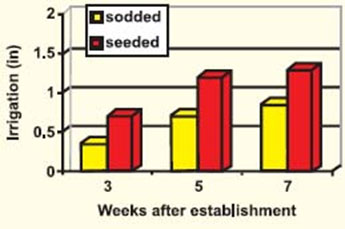Myth #1. It Takes More Water To Establish Sod.
This myth may have something to do with the fact that a large amount of water is used immediately after the sod is installed. Watering will ensure close contact between the sod roots and soil, and will prevent the sod from drying out. Once the sod roots have firmly grown into the soil, then less water is needed. This usually takes about two to three weeks. In comparison, seeding requires very high quantities of water to achieve germination and establishment. Multiple daily applications are needed to maintain adequate moisture to prevent the seed from drying out quickly on bare soil. Seeding usually takes several months to establish a turf and thus more water is needed before the turf matures. Therefore, sod has the lowest overall water requirements of all lawn establishment methods.
Dr. Peacock (2001) studied minimum irrigation requirements for establishing turf from sod, seed, and hydro-seeding methods during the spring (Figure 1). He found when sod received 1.3 inches of irrigation and was then not watered for two weeks, that it maintained acceptable turf quality. The seeded and hydro-seeded turfs never showed acceptable quality without irrigation during the same period.



